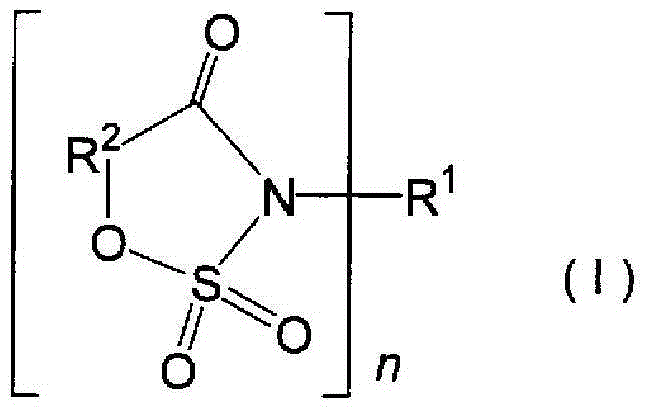Nonaqueous electrolyte solution for secondary batteries and nonaqueous electrolyte secondary battery
A technology of non-aqueous electrolyte and secondary battery, which is applied in the field of non-aqueous electrolyte for secondary battery and non-aqueous electrolyte secondary battery, can solve the problems of insufficient battery resistance battery characteristics and insufficient properties, and achieve improvement Charge and discharge characteristics, improve thermal stability, and prevent deterioration
- Summary
- Abstract
- Description
- Claims
- Application Information
AI Technical Summary
Problems solved by technology
Method used
Image
Examples
Embodiment 1
[0111] [Preparation of Electrolyte Solution]
[0112] Using LiPF 6 as an electrolyte. A solvent composed of a mixture containing 30% by volume of ethylene carbonate and 70% by volume of ethyl methyl carbonate was used. Dissolve LiPF in this solvent 6 It was adjusted to 1.0 mol / l, and a cyclic amide compound composed of N-acylsulfonate was added as an additive for forming an ion-conductive film on the electrode. In Example 1-1, 1.0% by weight of 3,6-dimethyl-3,4-dihydro-1,2,3- Thiazin-4-one 2,2-dioxide, in Example 1-2, 1.0% by weight of 6-methyl-3,4-dihydro-1,2 ,3- Thiazin-4-one 2,2-dioxide lithium salt, in Example 1-3, 1.0% by weight of 3-fluoro-6-methyl-3,4- Dihydro-1,2,3- Thiazin-4-one 2,2-dioxide, in Examples 1-4, 1.0% by weight of 5-fluoro-3-methyl-1,2,3- Thiazin-4-one 2,2-dioxide lithium salt, in Examples 1-5, 1.0% by weight of 6-methyl-3,4-dihydro-1 was added to 100% by weight of the solvent as a whole ,2,3- Thiazin-4-one 2,2-dioxide to obtain an electroly...
Embodiment 2-1~2-8
[0135] Regarding the fabricated examples 2-1 to 2-8, batteries were produced by the same method as in example 1-1, and 3,6-dimethyl-3,4-dihydro-1,2,3- The content of thiazin-4-one 2,2-dioxide was set to the amount shown in Table 2.
[0136] [Table 2]
[0137]
[0139] EMC: ethyl methyl carbonate
[0140] As shown in Table 2, the reaction resistance at low temperature increases with 3,6-dimethyl-3,4-dihydro-1,2,3- As the content of thiazin-4-one 2,2-dioxide increased, the resistance value decreased and showed a tendency to increase after showing a minimum value. In addition, the expansion rate at high temperature increases with 3,6-dimethyl-3,4-dihydro-1,2,3- The content of thiazin-4-one 2,2-dioxide increased and its swelling rate decreased. Therefore, according to the 3,6-dimethyl-3,4-dihydro-1,2,3- Examples 2-2 to 2-7 in which the content of thiazin-4-one 2,2-dioxide is set to be 0.05% by weight or more and 10% by weight or less, co...
Embodiment 3-1~3-3
[0142] In Example 3-1, except for 3,6-dimethyl-3,4-dihydro-1,2,3- In addition to thiazin-4-one 2,2-dioxide, 0.5% by weight of 2-acryloyloxyethyl isocyanate is added to the electrolyte composition. In Example 3-2, 0.5% by weight of 1, The electrolyte composition of 1-bis(acryloyloxymethyl) ethyl isocyanate, in embodiment 3-3, adopts the composition of electrolyte adding 0.5% by weight of 2-methacryloyloxyethyl isocyanate, except Otherwise, batteries were manufactured in the same manner as in Example 1-1, and the results of measuring the reaction resistance at low temperature and high temperature characteristics are shown in Table 3.
PUM
 Login to View More
Login to View More Abstract
Description
Claims
Application Information
 Login to View More
Login to View More - R&D
- Intellectual Property
- Life Sciences
- Materials
- Tech Scout
- Unparalleled Data Quality
- Higher Quality Content
- 60% Fewer Hallucinations
Browse by: Latest US Patents, China's latest patents, Technical Efficacy Thesaurus, Application Domain, Technology Topic, Popular Technical Reports.
© 2025 PatSnap. All rights reserved.Legal|Privacy policy|Modern Slavery Act Transparency Statement|Sitemap|About US| Contact US: help@patsnap.com



